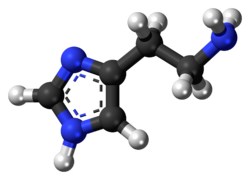| Scombroid food poisoning | |
|---|---|
| Other names | Scombrotoxin fish poisoning, scombroid syndrome, [1] scombroid, [2] histamine fish poisoning, [1] scombroid poisoning [3] |
 | |
| Histamine | |
| Specialty | Emergency medicine |
| Symptoms | Flushed skin, headache, itchiness, blurred vision, abdominal cramps, diarrhea [2] |
| Usual onset | After 10 to 60 min [2] |
| Duration | Up to 2 days [2] |
| Causes | Consumption of fish high in histamine due to improper processing [2] |
| Risk factors | Tuna, mackerel, mahi mahi, sardine, anchovy, herring, bluefish, amberjack, marlin. [2] |
| Diagnostic method | Typically based on symptoms, blood tryptase [2] [1] |
| Differential diagnosis | Allergic reaction, [2] fish allergy [1] |
| Treatment | Antihistamines, epinephrine [2] [3] |
| Frequency | Relatively common [2] |
| Deaths | Very rare [3] |
Scombroid food poisoning, also known as simply scombroid, is a foodborne illness that typically results from eating spoiled fish. [2] [4] Symptoms may include flushed skin, sweating, headache, itchiness, blurred vision, abdominal cramps and diarrhea. [2] [5] Onset of symptoms is typically 10 to 60 minutes after eating and can last for up to two days. [2] Rarely, breathing problems, difficulty swallowing, redness of the mouth, or an irregular heartbeat may occur. [2] [5]
Contents
- Signs and symptoms
- Initial
- Additional symptoms
- Severe
- Causes
- Diagnosis
- Prevention
- Treatment
- Epidemiology
- History
- References
- External links
Scombroid occurs from eating fish high in histamine due to inappropriate storage or processing. [2] Fish commonly implicated include tuna, mackerel, mahi mahi, escolar, sardine, anchovy, bonito, herring, bluefish, amberjack, and marlin. [2] [6] These fish naturally have high levels of histidine, which is converted to histamine when bacterial growth occurs during improper storage. [2] Subsequent cooking, smoking, or freezing does not eliminate the histamine. [2] Diagnosis is typically based on the symptoms and may be supported by a normal blood tryptase. [2] [1] If a number of people who eat the same fish develop symptoms, the diagnosis is more likely. [2]
Prevention is by refrigerating or freezing fish right after it is caught. [2] Treatment is generally with antihistamines such as diphenhydramine and ranitidine. [2] Epinephrine may be used for severe symptoms. [3] Along with ciguatera fish poisoning, it is one of the most common type of seafood poisoning. [2] It occurs globally in both temperate and tropical waters. [2] Only one death has been reported. [3] The condition was first described in 1799. [1]

